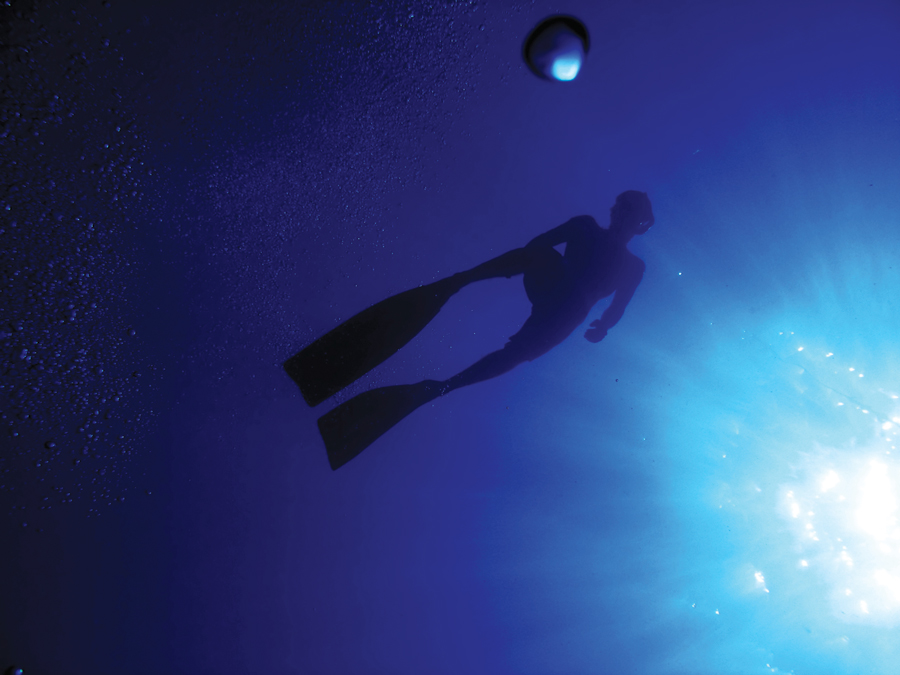There are approximately 639 skeletal muscles in the human body. Each is fueled by oxygen. And the harder a muscle works, the more fuel it requires. To be a good freediver—to dive deeper and hold your breath longer—you need to conserve and make efficient use of oxygen. Tense muscles, which work harder than relaxed ones, consume oxygen at a faster rate. So, it stands to reason that keeping your muscles supple and your mind and body relaxed will improve your oxygen efficiency . . . and your freediving.
Relaxation also helps you mechanically while freediving. Tense muscles in the torso can make it difficult for the lungs to expand to their full capacity, reducing the volume of air they can hold.
Lastly, relaxation helps you calmly react to the physical signals that your body sends while you freedive. For example, diaphragmatic spasms are one of the first “messages” your body sends to you when you’ve been holding your breath for a while. Staying relaxed will help you to remember that these sensations do not indicate that you are drowning, and to wait it out a little longer.
Massage and yoga—a recipe for relaxation
Sports massage is specifically designed for people who are involved in physical activity. Although the focus is less on relaxation than on mobility, the effect is the same—improved oxygen metabolism. Deep-tissue massage targets the deeper layers of muscle and connective tissue. The therapist uses slower strokes or friction techniques across the grain of the muscle. This type of massage is used for tight or painful muscles, repetitive strain, postural problems, or recovery from injury.
Freediving and yoga go together like peanut butter and chocolate. The two practices have interesting commonalities. And yoga includes three practices that can confer relaxation benefits that can significantly improve your freediving.
Yoga is known for its pretzel-like stretches. Instructors will tell students to “breathe into” the pose, using the breath to help the body calmly settle into the poses. These poses relax the body and the mind. With time and consistent practice, this relaxation can lead to improved oxygen metabolism.
Stretch your chest to improve lung capacity
Chiropractic care can help stretch and open your chest and torso. Likewise, some of yoga’s most well-known poses are excellent chest openers. Our lungs are like balloons, and our ribs truly are like a cage. Chest openers stretch out this cage, so the balloons (lungs) can more freely expand.
Here is an example—matsyasana, or “Fish Pose.” (In Sanskrit, “matsya” means fish, and “asana” means pose.)
Instructions for Fish Pose:
- Lie on your back.
- Come up onto your elbows.
- Slide your body towards the back of the mat, while keeping your forearms in place and puffing up your chest
- Drop the crown of your head back to the floor, opening your throat
- To come out, press strongly into your forearms and raise your head off the floor
- Release your upper body to the floor.
Beginners: Place a blanket or block under your head if the crown does not comfortably come to the floor.
Advanced: Bring your arms up towards the ceiling with the palms touching. Lift your legs.
Learn to control your breathing
As a freediver, you must learn how to use your body as a gauge. You will need to “read” your body’s signals to help you stay longer, deeper, and to know when to ascend. Yoga “pranayama” (or breath control) exercises can directly benefit your freediving. There are many pranayama techniques; the simplest of which is merely to be as conscious and aware of the breath as possible. This practice will definitely improve your ability to “read” your body.
Before trying yoga or visiting a new massage therapist or chiropractor, research your options. Sit in on a yoga class before you sign up. Read reviews of massage practitioners before making an appointment, if possible. Get personal references to a chiropractor.
Prepare to feel better than you have in a very long time. Stick with it and you will see amazing results, both physically and psychologically. And of course, these techniques will help you hold your breath longer and dive deeper!
Learn more about yoga poses and breathing exercises at www.yogajournal.com.
Story by Mark Lozano.

